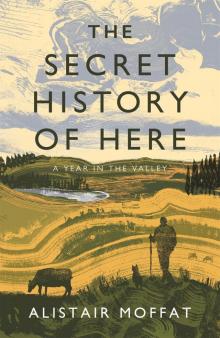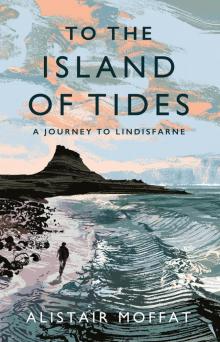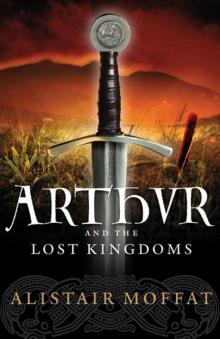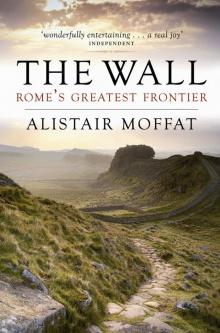- Home
- Alistair Moffat
Britain’s Last Frontier Page 22
Britain’s Last Frontier Read online
Page 22
On the morning of the 28 September, warriors from two Highland clans marched into the town, led by their pipers and their chiefs, Christy Johnson and Shaw Farquharson. Watched by royalty and nobility, 30 men from Clan Chattan would fight 30 men from Clan Cameron on the flat and green haughland by the Tay. And they would fight to the death with the last men standing declared the winners, the dispute between them finally resolved by the spilling of blood.
Arranged by Thomas Dunbar, the Earl of Moray, and Sir David Lindsay of Glenesk, what became known as ‘the Battle of the Clans’ was reported by several chroniclers. A very famous incident at the time, it was an important moment in the formation of stereotypes. Wild and uncivilised Highlanders had come out of the mountains to Perth to hack each other to death in front of an audience of civilised Lowlanders. Savages from the wrong side of the Highland Line would slaughter each other in a temporary coliseum costing a few pounds for the amusement of their superiors.
Walter Bower’s account in the Scotichronicon was the first time the word ‘clan’ occurs in any surviving documentary record and it immediately acquired a negative tone. Each clansman was armed with a crossbow and three bolts, swords, battleaxes and dirks and none was permitted to wear armour. This was to be a final judgement: ‘At once arrows flew on either side, men swung their axes, brandished their swords and struggled with each other; like butchers killing cattle in a slaughter-house, they massacred each other fearlessly; there was not even one among so many who, whether from frenzy or fear, or by turning aside from a chance to attack one another in the back, sought to excuse himself from all this slaughter.’
As the huge crowd no doubt roared, bayed and gasped, the killing went on. Men screamed, blood gushed on the grass as arteries were severed and some fell to their knees, bludgeoned into unconsciousness, stabbed to death by dirks. Many must have been badly wounded by crossbow bolts before the hand-to-hand fighting began but killing men with bladed weapons is rarely quick and the gory trial will not have reached a rapid verdict. Bower again: ‘[It was] a battle of great ferocity, in which out of the sixty all were killed except one from Clan Cameron and eleven from the other.’
It was said that the single survivor swam the Tay to escape the fate of all his comrades. Famous though it became, the Battle of the Clans was not, by itself, a seminal event. Instead, it formed part of a pattern, the culmination of decades of disorder in the Highlands, or so it seemed to Lowland commentators – although, in reality, it was a pattern mixed with paradox and contradiction.
The most notorious, rapacious and destructive Highland lord was known as the Wolf of Badenoch. Hugely powerful and wealthy, widely landed, a king in the north in all but name, he led bands of ferocious warriors known as caterans and, in return for what he saw as a slight from the Bishop of Moray, the Wolf burned the royal burgh of Elgin and destroyed its great cathedral in 1390. This caused outrage and was seen as yet more evidence of the mindless savagery and godlessness of the north. And, only six years afterwards, no one was surprised that more savages descended from the Highlands to slaughter each other on the North Inch at Perth. Such was the atavistic nature of the tribes of the mountains and glens.
This dichotomy, this stark distinction drawn between the lawlessness of the Gaelic-speaking north and the peaceful, civilised, English-speaking south does not bear much scrutiny. The Wolf of Badenoch was no tribal chief, no feral son of the wilderness but none other than Alexander Stewart, the third son of King Robert II of Scotland. Created Earl of Buchan by his father, he married Euphemia I, Countess of Ross in her own right. This combination of titles made Stewart supreme over vast tracts of the north of Scotland – from Buchan, he ruled over virtually all of the old kingdom of Moray on both shores of the firth and as far north as Caithness. Euphemia brought him much of the mainland north of the Great Glen as well as the islands of Skye and Lewis. In 1372, he was made Royal Justiciar. Not only did this give him additional lands in Perthshire for his great domain, it also gave him royal authority from there all the way north to the Pentland Firth. His dominance seemed immovable – but, by the 1390s, he had fallen far.
Lochindorb Castle was known as the Wolf’s Lair. Built on a small island in the middle of a loch that lay in the foothills of the Grampian massif, it was formidably secure, being defended by water and high walls. From there, the Earl of Buchan and Ross ruled but not without challenge. In the 12th and 13th centuries, the old kingdom of Moray had been enfeebled by the Scottish crown and the resulting power vacuum filled by the church. With appointments to the wealthy bishopric of Moray controlled by the kings of Scotland, it supplied a focus for authority but not one that could be passed on as any sort of inheritance. When Alexander Stewart was made Earl of Buchan and Ross, the church bristled. Bishop Bur of Moray complained that the bands of Highland soldiers in the service of Buchan, the caterans, were routinely raiding the lands of his tenants. But no formal protest could be made directly to the king since his viceregal representative in the north was none other than the commander of the unruly caterans, Alexander Stewart.
In any event, King Robert II was weak and ineffective to the point of ridicule. At 55, an old man when he succeeded David II, he attracted the unflattering nickname of Auld Bleary. By 1384, his eldest son, John, Earl of Carrick, had managed to remove his father from power, forcibly exiling him to Dundonald Castle in Ayrshire. For the sake of continuity and the avoidance of any link with King John Balliol, the Earl took the name of Robert III when Auld Bleary finally expired in 1390. But he fared no better. Badly crippled by a kick from a horse and being unable to take part in warfare, Robert III was himself eventually supplanted by his brother, Robert, Earl of Fife. He appointed himself Guardian of Scotland and, in effect, the Wolf of Badenoch became second in line. When Robert II died in 1406, his last, pathetic words were reported, and perhaps embellished a little, by Walter Bower, ‘Bury me therefore, I beg you, in a midden, and write for my epitaph: “Here lies the worst of kings and the most wretched of men in the whole kingdom”.’
The weakness of central authority had allowed licence both in the south and the north of the kingdom but, in 1388, Robert, Earl of Fife, reined in his rapacious younger brother. Alexander Stewart was summarily removed from his roles as Justiciar of the North and Sheriff of Inverness and replaced by his nephew, Murdoch. In 1389, more trouble boiled over. Perhaps driven by an impulse to adopt what he saw as the Celtic mores of his caterans and the powerful clans of the Highlands or simply because he wished to, Stewart abandoned his wife, Euphemia, and lived with Mairead Inghean Eachann. She may have been the daughter of Eachann of Strathnaver of the Mackay clan. While his power waxed unchallenged, Alexander could afford to ignore the laws of the church, live in sin and father children with Mairead.
But, after Robert of Fife’s initiatives began to dent his brother’s control of the north, Bishop Bur was emboldened. Since 1370, he had paid protection money to the Earl of Buchan but now he felt the balance of power shift. With the support of the Bishop of Ross, Bur directed Alexander Stewart to give up his sinful union with Mairead Inghean Eachann and return immediately to his legitimate wife. When the errant earl failed to live up to his promises of future fidelity, Robert of Fife encouraged Euphemia to begin the long and expensive process of seeking an annulment of the marriage at the papal court in Avignon.
Stewart was furious at being scolded by the church and his caterans descended from their lair at Lochindorb Castle in May 1390 and began to blaze a bloody trail through Moray. They burned the town of Forres and may have attacked Pluscarden Priory, a monastic house under the protection of Bishop Bur. When the caterans, described by John of Fordun as ‘wyld, wykked hielandmen’, overran Elgin in June, they wreaked tremendous destruction. The cathedral was torched, its roof blazing as its trusses cracked and fell and masonry tumbled, and the monastery of the Greyfriars, St Giles Parish Church and the Hospital of Maison Dieu in Elgin were all gutted and blackened. The sense of outrage was universal and the shock and sadness at the ruination o
f the cathedral is patent in Bishop Bur’s letter to Robert III: ‘[M]y church was the particular ornament of the fatherland, the glory of the kingdom, the joy of strangers and incoming guests, the object of praise and exaltation in other kingdoms because of its decoration, by which it is believed that God was properly worshipped; not to mention its high bell towers, its venerable furnishings and uncountable jewels.’
Retribution was immediate. Church and state combined to tame the Wolf. Almost certainly in the smoking ruins of his desecrated cathedral, Bur passed sentence of excommunication on Stewart. A bell tolled as if for the dead, the Bible was slammed shut and a lit altar candle upended and snuffed out on the floor. Condemned by bell, book and candle, the Wolf was now alone, living beyond the church, outcast and bound for the eternal torments of Hell. He had no choice but to repent and seek forgiveness.
At the Church of the Blackfriars in Perth, a court assembled. In front of his brothers, King Robert III and the Earl of Fife, and the royal council, Stewart was forced, on his knees, to beg for the sentence of excommunication to be lifted. After an appropriate process of humiliation, absolution was granted by Walter Traill, Bishop of St Andrews. But the events at Blackfriars were not the beginning of a road to rehabilitation. In 1392, Euphemia I was granted an annulment of her marriage and, at the stroke of a papal pen, Stewart lost the great earldom of Ross. And, in the same year, he was forced to give up the lordship of Urquhart, valuable lands along the shores of Loch Ness.
Disorder did not cease with the daunting of the Wolf of Badenoch. In the same year as Elgin blazed, events on the southern fringes of the Highland Line helped build the stereotype of wild, wicked men from the mountains. Duncan Stewart, an illegitimate grandson of Robert II and nephew of the Wolf, led a raiding party, described as ‘ane infamous byke o’ lawless lymmers’ by John of Fordun, out of the southern ranges of the Grampians to reive cattle in Glen Isla. These lawless rascals drove their plundered beasts to the valley of the Lornty Burn near Blairgowrie where they were caught by a band of pursuers. A series of skirmishes followed and the Angus men were driven back by the caterans. When Sir Walter Ogilvy and Sir David Lindsay arrived with a force of heavily armed cavalry, perhaps as many as sixty horsemen, battle was joined once more. But, against all the logic of war, the Highlanders, armed only with claymores, targes or shields and long dirks, scattered their pursuers once again, killing Ogilvy. One incident became famous – an archetype for savagery. When Sir David Lindsay drove his lance through one of the caterans and pinned him to the ground, the dying man pulled himself up the shaft and slashed at the knight with his claymore. Such was the rage and force of the blow that it cut through Lindsay’s stirrup and steel boot, right to the bone. The ferocity of such men was scarcely human, more a force of nature. And, when the wooden coliseum was built around the North Inch in Perth, the combatants were seen as a different, feral breed of men, not of the same race as the Lowlanders who sat in the grandstands.
Like most stereotyping, it was of course a nonsense. Much of the serial disorder that had painted the Highlanders as savages, as ‘wyld wykked’ men, had been instigated by members of the royal family, much of it by the king’s brother. Across most of the Highland massif, on the Atlantic shore and in the Hebrides, the Lords of the Isles ruled and they were a force for stability not anarchy. And, in many ways, their style of governance was a lesson for the weakness and fractiousness of central government in the Lowlands and the Borders. And, in Moray and in Angus, what was visible to Lowlanders and what was eagerly reported by chroniclers was a set of characteristics unfairly applied to all who lived north and west of the Highland Line. But, when the army of the Lords of the Isles marched to do battle at Harlaw in 1411, there was formality, even dignity.
The great Atlantic principality of the Isles was, in its essence, a realm of the sea. Held secure by a linked network of castles that did not look over valuable tracts of land but guarded the sea roads between the islands, it was governed by the leading men of Clan Donald. It was originally the creation of Somerled the Viking, a 12th-century warrior of Celto–Norse descent who made himself King of the Isle of Man and Dominus Insularum, Lord of the Isles. In 1164, he led a naval expedition into the Firth of Clyde to challenge Malcolm IV of Scotland but, at Renfrew, Somerled was killed. It was not to be the last time the Lordship threatened a Scottish king.
The principality was strengthened and re-formed in the first half of the 14th century. When John MacDonald of Islay married Amie niRuari, he found himself in control of the coastline and all of the islands from Skye down to the Mull of Kintyre. At Finlaggan in the centre of Islay, the Council of the Isles met regularly and four great men of the royal Clan Donald blood came to consider matters of policy and to resolve disputes. They were the chiefs of Clanranald, MacIain of Ardnamurchan, MacDonald of Kintyre and MacDonald of Keppoch. Four centuries later, their descendants would lead the MacDonald regiments across the heather at Culloden. Four powerful chiefs of other names also had the right to attend – Maclean of Duart, Maclaine of Lochbuie, Macleod of Harris and Macleod of Lewis – and they were joined by four lesser men – Mackinnon, MacNeil of Barra, MacNeil of Gigha and one other who may have taken his place by rotation. Also present was the Church, in the shape of the Bishop of the Isles and the Abbot of Iona, men who were themselves usually aristocrats from the great families.
Laws were codified and administered by a hereditary caste of judges known as ‘brieves’. Little was written until much later, all retained in memory and recited just as the Deemsters of Man still do at Tynwald. What guided the principles of the laws of the Isles was the notion of punishment by reparation rather than judicial revenge. Offenders sentenced by the brieves were more likely to have their crimes measured against a tariff of fines or do onerous services rather than have their hands or heads cut off.
Under the Lordship, the Hebrides and the Atlantic littoral prospered. Tiree was the corn basket of the Isles and the tax yield from Islay so substantial that it spoke of a prodigious annual agricultural output. In their beautifully sited sea castles, the MacDonald lords flourished, growing wealthy and powerful. In 1411, Donald of the Isles was at Ardtornish. Reachable overland by only the roughest of tracks, it communicated with the MacDonald realm by sea and dominated the busy mercantile and military traffic between the islands and the mainland. Looking out over the Sound of Mull, it stood above a wide and sheltered bay where a hundred birlinns could be safely beached. Often also called galleys, these small, highly manoeuvrable warships had brought Somerled several naval victories two centuries before. The arms of Clan Donald have a birlinn at the centre for these little ships were at the core of all they achieved. When Donald MacDonald sent out messengers to call for a muster of the army of the Lordship in 1411, many birlinns answered and thousands of warriors and their captains rowed into the bay at Ardtornish. In the east, a great prize waited to be won.
Through his marriage to Mariota, Euphemia I’s aunt and the oldest living descendant of the last earl, Donald claimed the huge territories of Ross. It would bring him Lewis, Harris and a great landholding on the mainland. It would make him more powerful than Somerled. With ambition high and perhaps imitation of the audacity of his great ancestor in his mind, the Lord of the Isles concluded a treaty with King Henry IV of England. They would divide Lowland Scotland between them and banish the squabbling Stewarts to a footnote in history. This was no extravagant fancy but a recurring theme. In 1462, John of Islay and Edward IV of England formally attached their seals to the treaty of Westminster–Ardtornish and it agreed that James III would be deposed and Scotland south of the Forth would be absorbed into Greater England.
A victorious campaign in 1411 would bring Donald as much, maybe more, and early success encouraged the army of the Lordship. Unopposed, they marched up the Great Glen and defeated the forces of Clan MacKay of Strathnaver and seized Dingwall Castle. At Inverness, Donald sent out messengers to the men of western Moray to summon them to his standards and his forces swelled. Having
swept through the Moray coastlands, the Islesmen closed in on Aberdeen, the Mounth, the hinge of the north and the road to Angus and the Lowlands.
The Earl of Mar had heard news of the fall of Dingwall and the muster at Inverness. Determined to prevent the clansmen from reaching and burning Aberdeen, Mar led a large party of mounted knights and well-armed infantry out to meet the threat from the west. In the shadow of Bennachie, only a mile or so from where the centurions had drawn up Agricola’s legions in battle order, the Lowland army halted. It was the morning of Friday 24 July and, on a flat area of haughland by the River Urie, near Harlaw House, perhaps five thousand men stood to and waited.
The Islesmen and their captains knew that victory would open Scotland to them, Aberdeen would be plundered and fired and the road to the south would be clear. They watched the Lowland infantry form themselves into bristling schiltrons – a schiltron is a military formation in which the men stand shoulder to shoulder, with their long spears ‘couched’ or grounded and the ranks behind pushing their shafts between their comrades to present a dense concentration of sharpened points. Mar may have marshalled three schiltrons with his force of armoured knights behind them, positioned so that they could ride quickly to shore up crises or break open opportunities. And, in the van, in front of the main body of the army, Sir James Scrymgeour of Dundee stood with a small force of men-at-arms.

 The Secret History of Here
The Secret History of Here The Night Before Morning
The Night Before Morning To the Island of Tides
To the Island of Tides Arthur and the Lost Kingdoms
Arthur and the Lost Kingdoms Britain’s Last Frontier
Britain’s Last Frontier The Faded Map: The Lost Kingdoms of Scotland
The Faded Map: The Lost Kingdoms of Scotland The Wall
The Wall